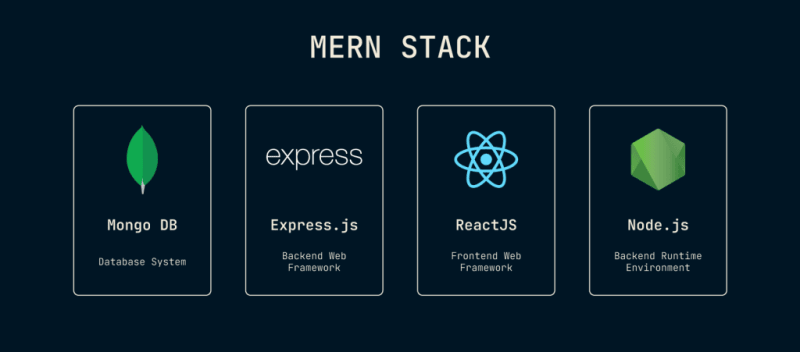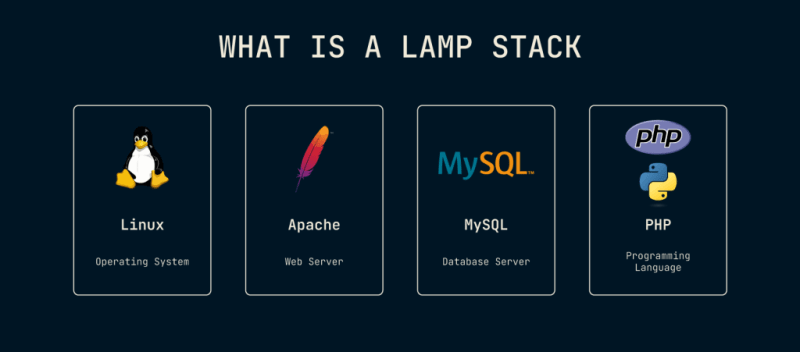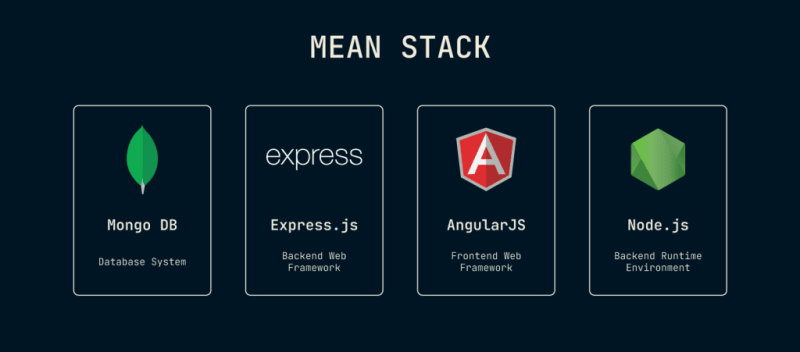Web development evolves rapidly with new technologies and frameworks emerging daily. As a software engineer, selecting the appropriate technology stack for your projects is a critical decision, but with numerous options available, it can be overwhelming.
A common dilemma developers face is choosing between the MEAN and MERN stacks. In this blog post, we'll decode both stacks, compare features, and guide you in making the right decision.
-
MEAN Stack: The JavaScript Ecosystem
-
MERN Stack: Powering the Web
-
Comparing the Two Stacks: MEAN vs MERN
MEAN Stack: The JavaScript Ecosystem
The MEAN stack is an acronym that stands for MongoDB, Express.js, AngularJS, and Node.js.
It has gained popularity due to its unified language (JavaScript) across all layers of the stack. This offers several advantages, such as code reusability, easier communication between frontend and backend developers, and a shorter learning curve. Additionally, the MEAN stack is suited for real-time applications and provides excellent scalability for handling large amounts of data.
Let's take a look at each component to understand its role in the stack:
MongoDB
MongoDB is a popular open-source NoSQL database that stores data in JSON-like documents. It provides scalability, flexibility, and ease of use. With its dynamic schema and horizontal scaling capabilities, MongoDB is an excellent choice for applications with rapidly changing requirements and high data volume.
Express.js
Express.js is a minimalist web application framework for Node.js. It simplifies the process of creating server-side applications and APIs, handling routes, and managing middleware. Express.js provides a robust set of features, including templating engines, session management, and error handling.
AngularJS
AngularJS is a JavaScript framework developed and maintained by Google. It's known for its declarative approach to building user interfaces, two-way data binding, and modular structure. AngularJS provides a comprehensive set of tools for building dynamic web applications, including dependency injection, testing utilities, and an extensive set of reusable components.
Node.js
Node.js is an asynchronous JavaScript runtime built. It brings JavaScript to the server side, allowing developers to use the same language for both client-side and server-side development. Node.js has a non-blocking, event-driven architecture, making it highly performant and efficient, especially for I/O-intensive applications.
MEAN is well-suited for applications with real-time features, social media platforms, collaboration tools, and data-intensive applications. However, it may not be the best choice for content-focused websites or projects requiring complex data relationships.
If you want to delve deeper into the MEAN stack, check out the official documentation of:
MERN Stack: Powering the Web
The MERN stack is an alternative to the MEAN stack, replacing AngularJS with React.
The MERN stack offers several benefits. It provides a consistent development experience with JavaScript used across the entire application stack. React, as a component-based library, enhances code reusability and maintainability. The MERN stack is also highly suitable for building single-page applications with interactive user interfaces.

Let's take a closer look at each component:
MongoDB
Like in the MEAN stack, MongoDB serves as the database in the MERN stack. Its flexibility and scalability make it a reliable choice for storing data in JSON-like documents.
Express.js
Express.js plays the same role in the MERN stack as it does in the MEAN stack. Its simplicity and powerful features make it an excellent choice for handling server-side logic.
React
React is a JavaScript library developed by Facebook. It's known for its component-based architecture, virtual DOM, and efficient rendering. React provides a smooth development experience with its reusable components and one-way data flow, resulting in fast and responsive applications.
Node.js
Similar to the MEAN stack, Node.js is used as the server-side runtime in the MERN stack. Its asynchronous, event-driven nature makes it an ideal choice for developing scalable and high-performance web applications.
MERN is an excellent choice for large-scale applications, e-commerce platforms, social media applications, and applications that require real-time updates. However, it may not be the best fit for projects with minimal front-end requirements or those that rely heavily on server-side rendering
If you're interested in exploring the MERN stack further, you can checkout the official documentation of React here
Comparing the Two Stacks: MEAN vs MERN
Now that we have a good understanding of both stacks, let's compare them based on some key factors:
Learning Curve
When it comes to the learning curve, the MEAN stack may have a steeper curve due to the complexities of AngularJS. AngularJS requires a deep understanding of its concepts and features, which can take some time to master. On the other hand, React, used in the MERN stack, has a simpler learning curve, making it easier for developers to get started quickly.
Community and Ecosystem
Both the MEAN stack and the MERN stack have active communities and extensive ecosystems. You can find numerous tutorials, libraries, and resources dedicated to each stack.
Flexibility and Scalability
When it comes to flexibility and scalability, both stacks offer similar capabilities. MongoDB's flexible schema allows for easy modification of data structures, which is beneficial for rapidly evolving applications. Additionally, both stacks leverage Node.js, which provides excellent scalability through its non-blocking, event-driven architecture.
Performance
In terms of performance, both stacks are highly performant. However, React's virtual DOM and efficient rendering make it slightly faster than AngularJS. React's one-way data flow also simplifies tracking changes and updating views, resulting in improved performance.
Exploring LAMP: An Alternative to MEAN and MERN

While the MEAN and MERN stacks have garnered significant attention as the most popular tech stacks, there are also other powerful options like LAMP, which stands for Linux, Apache, MySQL, and PHP (or Perl/Python).
The LAMP stack has several advantages. First, it is cost-effective, as all its components are open-source and free to use. It also enjoys great community support, with numerous online resources, tutorials, and forums available. Moreover, it is highly flexible, allowing developers to choose the tools and frameworks that best suit their project requirements. Let's break down its components:
Linux
The operating system forms the foundation of the LAMP stack. It provides stability, security, and flexibility, making it an excellent choice for web servers
Apache
The Apache HTTP Server is a reliable and powerful web server that serves web pages to clients. It is highly customizable and supports a wide range of modules, making it ideal for hosting dynamic websites
MySQL
The M in LAMP does not represent MongoDB like our previous competitors but instead, it represents the MySQL database management system. MySQL is a widely-used open-source relational database that offers excellent scalability and performance. It integrates seamlessly with the other components of the stack
PHP
PHP is the most common programming language used in the LAMP stack. It is renowned for its simplicity and is particularly suited for web development. Alternatively, developers can use Perl or Python as backend programming languages
The LAMP stack is an excellent choice for small to medium-sized websites, content management systems, and e-commerce platforms. However, it may not be as suitable for real-time applications or projects requiring high performance and scalability.
MEAN vs MERN: Which Stack Wins?
Deciding on the best stack for your next web project can be a tough choice. Both the MEAN stack and the MERN stack have their strengths and weaknesses.
If you prefer a fully JavaScript stack with a comprehensive framework for building complex applications, the MEAN stack might be the right choice for you. On the other hand, if you value simplicity, reusability, and fast rendering, the MERN stack with React could be the better option.
Remember, the boundaries between these stacks are not rigid, and you can mix and match components based on your project's needs. Explore the documentation, engage with the vibrant developer communities, and experiment to find the stack that works best for you.
Ultimately, the choice depends on your project requirements, your familiarity with the technologies, and your team's expertise. Regardless of the stack you choose, remember to stay updated with the latest trends and best practices to ensure the success of your web project.
Whether you decide to go with the MEAN stack or the MERN stack, both offer powerful tools and frameworks to build modern web applications. The decision lies in understanding your project's needs, your team's expertise, and your personal preferences.
If you are a developer who actively explores new technologies like MEAN, MERN, and LAMP, you should try Five – a low-code development environment that allows you to rapidly build and deploy web applications.
It provides a MySQL database with every application you create using it, giving you absolute control over that database. On top of that, every application inside Five is automatically containerized with Docker and Kubernetes. Get started with a free download of Five now!




Top comments (0)